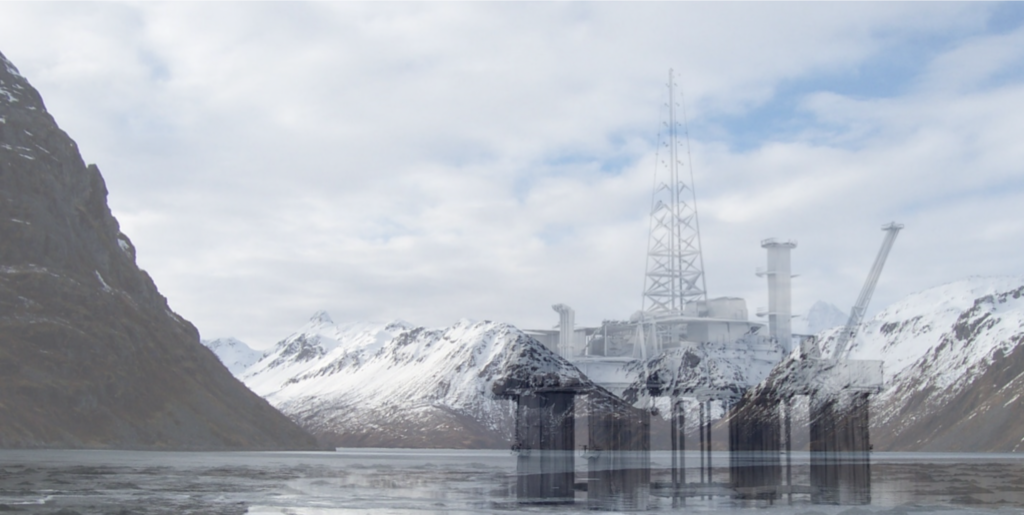
“Offshore Oil Rig.” Philippe Putt, available here.
By: Theresa Geib
On December 20, 2016, President Obama withdrew 119 million acres of the outer continental shelf (“OCS”) to “[prevent] consideration of this area for any future mineral leasing for purposes of exploration, development, or production.”[1] In an attempt to make available the portions of the OCS that were withdrawn in 2016, President Trump issued Executive Order 13795, titled “Implementing an America-First Offshore Energy Strategy,” on April 28, 2017.[2] “By proposing to open up nearly the entire OCS for potential oil and gas exploration, the United States can advance the goal of moving from aspiring for energy independence to attaining energy dominance.”[3] Ryan Zinke, U.S. Secretary of the Interior, proposes that opening up 90% of the OCS and 98% of all undiscovered and technically available oil and gas reserves will enable the United States to achieve “energy dominance.”[4] However, in early 2019, a federal district court in Alaska struck down a portion of the 2017 executive order, questioning whether the president has the statutory power to rescind an existing withdrawal of federal lands under the Outer Continental Shelf Lands Act (“OCSLA”).[5]
Section 12(a) of OCSLA is ambiguous because the phrase “from time to time” introduces multiple interpretations to the delegation of withdrawal power to the President.[6] Ultimately the district court adopted an interpretation of Section 12(a) that reserved revocation powers for Congress.[7] The federal government, Alaska, and the American Petroleum Institute have filed an appeal in the 9th Circuit, challenging this narrow interpretation of the statute.[8] Nevertheless, the 9th Circuit is most likely to uphold this interpretation because the legislative history indicates a clear intent to limit the scope of the delegated powers.[9]
First, looking to the plain language of OCSLA, the text does not address how to reverse the withdrawal of lands from the OCS.[10] The statute only states, “[t]he President of the United States may, from time to time, withdraw from disposition any of the unleased lands of the outer Continental Shelf.”[11] This statute does not present an express statutory authority to revoke a prior withdrawal of lands; therefore, an implied authority over a prior withdrawal would violate the separation of powers doctrine.[12]
Second, while OCSLA was drafted as a framework for oil and gas development in the OCS, Congress also acknowledged that development of these lands “will have significant impacts on coastal and non-coastal areas. . . .”[13] Therefore, it incorporated a mechanism to protect “affected areas from any temporary or permanent adverse effects of such impacts.”[14] This protective purpose would be severely undermined if every president had the power to unilaterally remove lands from indefinite protection.[15]
The
importance of upholding this interpretation of OCSLA Section 12(a) will limit the expansion of offshore
oil and gas development and strengthen a president’s ability to promote
conservation. Although this is not an absolute restriction, if Congress decides
to repeal President Obama’s prior withdrawal, these regions can be reopened for
exploration and development of oil and gas resources.[16]
[1] See Outer Continental Shelf Lands, 43 U.S.C. § 1341(a) (2019); Kevin O. Leske, “Un-Shelfing” Lands Under the Outer Continental Shelf Lands Act (OCSLA): Can a Prior Executive Withdrawal Under Section 12(A) Be Trumped by a Subsequent President?, 26 N.Y.U. Envtl. L.J. 1, 3-4 (2017).
[2] Exec. Order 13795, 82 Fed. Reg. 20815, §§ 4(c), 5 (Apr. 28, 2017); see generally Environmental & Energy Law Program Staff, Executive Order 13868 on Promoting Energy Infrastructure and Energy Growth, Harv. L. Sch. (Apr. 25, 2019) https://eelp.law.harvard.edu/2019/04/executive-order-on-promoting-energy-infrastructure-and-energy-growth/.
[3] Press Release, U.S. Department of the Interior, Secretary Zinke Announces Plan for Unleashing America’s Offshore Oil and Gas Potential (Jan. 4, 2018).
[4] See Id. (proposing a significant increase in oil exploration compared with the restrictions in place during the Obama administration, which restricted oil development in 94% of the OCS).
[5] See League of Conservation Voters v. Trump, 363 F. Supp. 3d 1013, 1020-1031 (D. Alaska 2019) (analyzing the statutory text, legislative history, and purpose of the Outer Continental Shelf Lands Act to determine the scope of the president’s power); see also Juan Carlos Rodriguez, Trump Lacks Power to Lift Ocean Drilling Ban, 9th Circ. Told, Law360 (Feb. 14, 2020, 9:50 PM) https://www.law360.com/articles/1244450/trump-lacks-power-tolift-ocean-drilling-ban-9th-circ-told.
[6] League of Conservation Voters, 363 F. Supp. 3d at 1024 (interpreting the phrase to either mean the president can withdraw lands at any time and even designate an indefinite duration or to broadly give the President the power to revoke or modify any prior withdrawal).
[7] Id. at 1030-31.
[8] Federal Appellant’s Opening Brief at 45-50, Trump v. League of Conservation Voters, No. 19-35460 (9th Cir. Nov. 7, 2019).
[9] Leske, supra note 1, at 27-28, 40 (identifying that Congress viewed the outer continenetal shelf as public lands akin to “upland” public lands which the president did not have the authority to restore previously withdrawn lands).
[10] § 1341(a).
[11] Id.
[12] Leske, supra note 1, at 23.
[13] § 1332(4).
[14] Id.
[15] See id.; Leske, supra note 1, at 30.
[16] League of Conservation Voters, 363 F. Supp. 3d at 1030-31.

